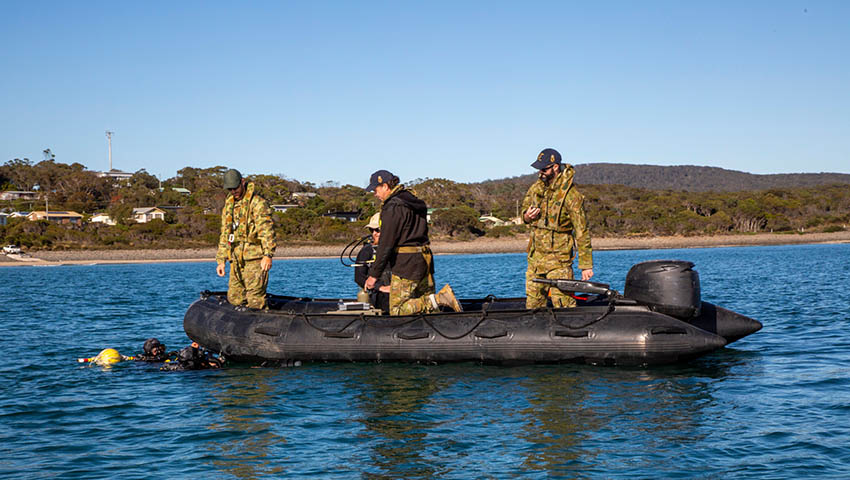A Maritime Advanced Force task unit has successfully demonstrated the Royal Australian Navy’s ability to open and maintain sea lanes for amphibious operations during Fleet Certification Period 2020 (FCP20).
To continue reading the rest of this article, please log in.
Create free account to get unlimited news articles and more!
The task unit, comprising of Australian Clearance Diving Team One (AUSCDT ONE) and minehunters Huon and Diamantina, worked together to provide a persistent forward presence by undertaking mine clearance operations in Tasmanian waters to safely clear a route for an amphibious landing.
Commanding Officer of HMAS Huon and Task Unit Commander, Lieutenant Commander Robert Short, said unit elements each took on different roles to create a positive combined effect.
"HMAS Huon and Diamantina predominately worked in waters greater than 12 metres and used their two mine disposable vehicles on-board to clear mines ahead of the force. Clearance Diving Team One worked in depths less than 12 metres and cleared the beach access," LCDR Short explained.
During the exercise, AUSCDT ONE’s beach clearance was focused on anti-invasion mines, which are a very real threat to amphibious forces and a cost-effective and easy way for adversaries to deny access to land and sea.
AUSCDT ONE Expeditionary Reconnaissance and Clearance Officer, Lieutenant Douglas Allen, explained the importance of the Clearance Diver Teams in helping support amphibious warfare operations, while protecting larger fleet assets.
"Anti-invasion mines are smaller and targeted towards landing craft and amphibious vehicles. Their capabilities range from basic contact to magnetic, acoustic, seismic pressure and any sensors that are able to fit into the package," LEUT Allen said.
To 'link' the two operational areas, a new mine countermeasure capability was tested with Navy Innovations Team working with Defence Science and Technology Group to integrate automated underwater vehicles (AUVs) into the operation.
LCDR Short added, "The AUVs are a step change for the Australian Navy in that we can search, locate, identify and potentially prosecute mines with our people outside the mine field.
"The more distance we can put between a potential explosion and our people, the safer and potentially more accurate it will be as we integrate autonomous activities and human processing power."
LCDR Short said FCP20 has been a positive exercise for the task unit who took the opportunity to work out better engagement processes with the ever-adapting Maritime Task Group.
"Operating with the Maritime Task Group has been very beneficial in ironing out our reporting requirements and making sure we have a clear message when the beach is ready for the Task Group to conduct amphibious operations," he said.
Exercises like FCP20 are a critical component of delivering Chief of Navy's Plan Pelorus 2022, as outlined at Pacific 2019 in Sydney.
A key component of Plan Pelorus 2022 is the renewed focus on Australia's immediate region, the Indo-Pacific:
"We live in an increasingly complex geo-political environment, within a dynamic Indo-Pacific region. The maritime domain is central to the security and prosperity of our nation. As resources become increasingly scarce, and the competition greater, all elements of national power must work together to achieve the desired outcomes for our nation, and those of our friends. Fuelled by technological advances and availability of information, the future is increasingly unpredictable," the planning statement said.
For Chief of Navy and the government as a whole, Navy operating as a critical 'sensor-shooter' combination within the broader 'joint force' will serve as a major force multiplier for Navy and as the guiding development principles for the introduction of Plan Pelorus 2022.
This renewed focus is broken down into seven key focal points, each with an interlocking and overlapping tactical and strategic impact for the development of the future Navy, its operating capacity and strategic capability into the middle of the 21st century.
Plan Pelorus 2022 reflects a significant undertaking when each element of the statement is defined:
- Workforce: We will be fully crewed at sea and staffed ashore, able to train for future demand, and prepared for continued growth;
- Lethal: We will be able to deny, deter and defeat our adversaries in the face of evolving threats and challenges;
- Integrated: We are integrated with the joint force and operate effectively with our allies and like-minded partners;
Battleworthy: We will provide sea, air and cyber worthy platforms to the Chief of Joint Operations; - Sustained: Our resources are optimised to enable conduct of all our activities and our future commitments;
- Persistent: We will be able to maintain a long-term presence away from our home ports; and
- Near region: Engaged across the Indo-Pacific; we meet all domestic requirements and work closely with our friends and partners in the near region.
Involving more than 2,000 military personnel, the sea phase of FCP20 was held in the Bass Strait until 6 March, with participating ships also visiting ports in Victoria and Tasmania.

 Login
Login







